Online exhibits : Special exhibits : Fossil footprints

Fossil footprints through geologic time
IV. Who made these fossil tracks?
By Allison Vitkus, Karen Chin, and Martin Lockley
Dinosaur footprints are the most familiar fossil tracks, but many different types of animals have left their footprints in the rock record over the long course of Earth's history. Check out the images below of fossil tracks in the paleontological collections of the University of Colorado. Can you figure out which types of animals made these fossil tracks?
Click on the hints for clues.
Track mystery 1:
This track (UCM 183.60/US National Park Service specimen)1 was made during the Early Jurassic (around 200 million years ago) in what is now Utah, USA. This track was found at the transition between the Kayenta and Navajo formations, where river sediments were replaced by dune deposits. Who made this track?
Track mystery 2:
This trackway (UCM 167.2/US National Park Service specimen)1 was made in shallow marine sediments during the Triassic Period (between 201 million and 252 million years ago) in what is now Arizona, USA. Who made this track?
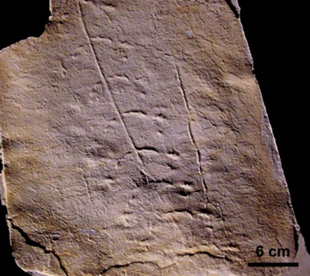
|
|
Track mystery 3:
This specimen (UCM 230.86)1 is a replica of a track made in a cave in what is now the state of Missouri, USA. The track was made during the Pleistocene Epoch, which lasted from about 2.6 million to 11,500 years ago. This is relatively recent in comparison to the ages of the rest of the tracks featured on this website! Who made this track?
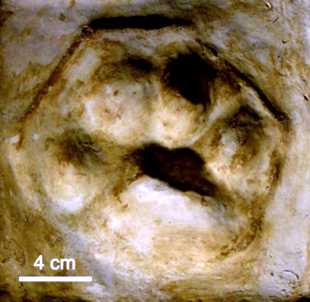
|
|
Track mystery 4:
These tracks (UCM 139.93)1 were made on a sand dune during the Permian Period (between 252 and 299 million years ago) in what is now Arizona, USA. Who made these tracks?
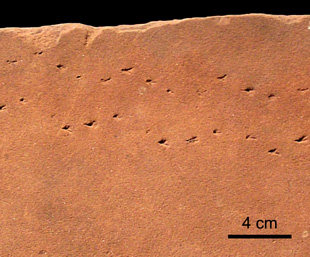
|
|
Track mystery 5:
This slab (UCM 187.30)1 shows two types of tracks that were made during the middle of the Jurassic Period (roughly 160 million years ago) in terrestrial sediments of what is now Argentina. The lower left-hand corner has a single track of one type of animal, and the other tracks on the slab are part of a trackway of another type of animal. These are natural casts of the tracks — that is, we are looking at a worm's-eye view of the tracks. Who made these tracks?
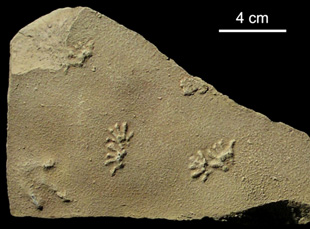
|
|
Track mystery 6:
The track below (UCM 207.8)1 was found in the Dakota Group, a complex of sedimentary rocks that are around 100 million years old. The Dakota Group rocks were deposited along the western edge of the Western Interior Seaway, the sea that bisected North America during most of the Cretaceous Period (~145 to 66 million years ago). This is a cast of the track, which was found in Colorado, USA. Who made this track?
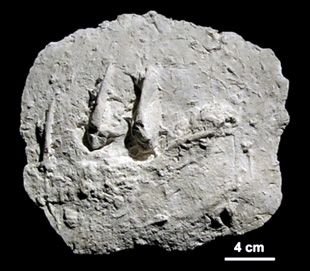
|
|
Track mystery 7:
These tracks (UCM 155.44/US Bureau of Land Management specimen)1 were made during the Triassic Period in what is now Colorado. They were found in the Chinle Formation, which was deposited in a terrestrial setting around 225 million years ago. Who made these tracks?
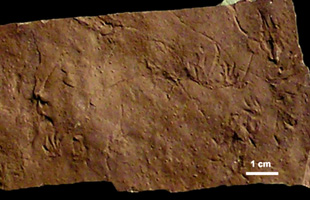
|
|
Track mystery 8:
The tracks below (UCM 139.97)1 show that an animal moved across a sand dune during the Permian Period (between about 252 and 299 million years ago) in what is now the western United States. Who made these tracks?
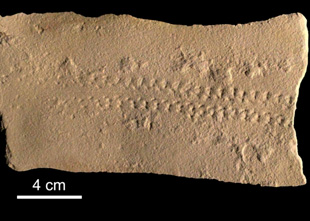
|
|
Track mystery 9:
The tracks below (UCM 200/State of Colorado specimen)1 were found at a site now known as Dinosaur Ridge in Colorado, USA. The footprints were found in the Dakota Group, which includes sediments deposited on a coastal plain during the middle part of the Cretaceous Period, about 100 million years ago. Who made these tracks?
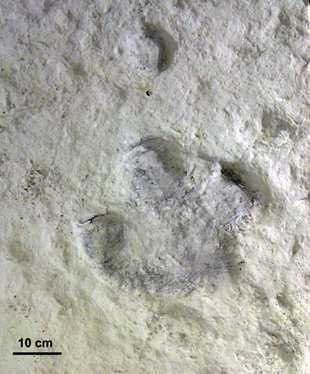
|
|
Track mystery 10:
This rock slab (UCM 139.15/)1 shows a trackway made on a sand dune in what is now Arizona, USA, during the Permian Period (sometime between 299 and 252 million years ago). Who made these tracks?
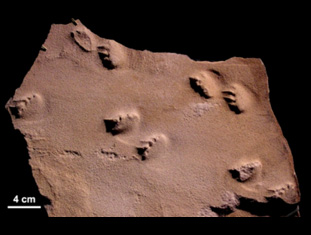
|
|
Track mystery 11:
The tracks below (UCM 188.102)1 were found in the Sundance Formation, which includes marine and coastal sediments. These tracks were made around 160 million years ago during the Jurassic Period in what is now Wyoming, USA. Who made these tracks?
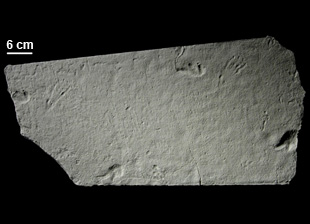
|
|
Track mystery 12:
This slab (UCM 230.77)1 shows two sets of fossil tracks that were made in what is now Colorado, USA, during the Miocene Epoch, which lasted from around 23 to 5 million years ago. The tracks were found in the non-marine Browns Park Formation. Who made these tracks?
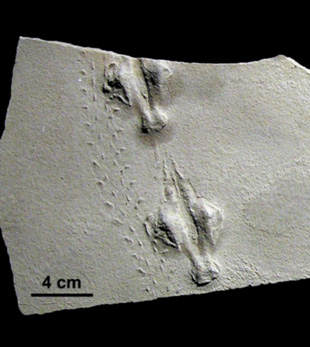
|
|
Track mystery 13:
These tracks below (UCM 230.243)1 were made in terrestrial sediments in what is now Arizona, USA during the Miocene Epoch, which lasted from around 23 to 5 million years ago. Who made these tracks?
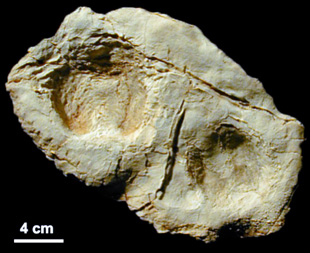
|
|
Track mystery 14:
These tracks (UCM 203.4/State of Colorado specimen)1 were made around 100 million years ago during the middle part of the Cretaceous Period in what is now Colorado, USA. These tracks were found in the Dakota Group, which was deposited in shallow marine and coastal sediments. Who made these tracks?
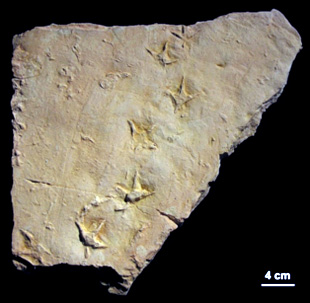
|
|
Track mystery 15:
This track (UCM 189.7/US Bureau of Land Management specimen)1 was made in what is now Colorado, USA, during the late Jurassic Period, around 140 million years ago. It was found in the Morrison Formation, which is composed of sediments from ancient lakes and rivers. Note that this is a positive cast of a track — that is, it is the hardened sediment that once filled a footprint impression. Who made this track?
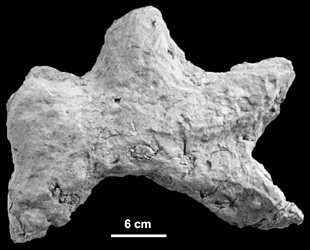
|
|
1UCM refers to the University of Colorado Museum of Natural History. The collection was originally built by the University of Colorado Denver, and was displayed at the Dinosaur Tracks Museum on the Denver campus. The fossil tracks are now housed at the University of Colorado Museum of Natural History in Boulder, Colorado, and the images of these specimens are courtesy of the University of Colorado.